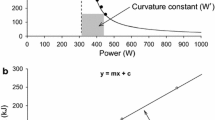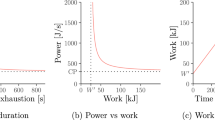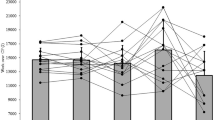Abstract
This paper develops and illustrates the critical power model for intermittent work. Model theoretic development reveals that total endurance time is always a step function of one or more of the four independent variables: work interval power output (P w), rest interval power output (P r), work interval duration (t w), and rest interval duration (t r). Six endurance-trained male athletes recorded their best performances during the season in 3-, 5-, and 10-km races, and performed three different intermittent running tests to exhaustion in random order, recording their total endurance times. These data were used to illustrate the model and compare anaerobic distance capacities (α) and critical velocities (β) estimated from each type of exercise. Good fits of the model to data were obtained in all cases: 0.954<R 2<0.999. Critical velocity was found to be significantly less when estimated using an intermittent versus continuous running protocol.


Similar content being viewed by others
References
Astrand PO, Rodahl K (1970) Textbook of work physiology. McGraw-Hill, New York
Billat V, Koralsztein JP, Morton RH (1999) Time in human endurance models. Sports Med 27:359–379
Christensen EH (1960) Intermittent and continuous running. Acta Physiol Scand 50: 269–275
Ettema JH (1966) Limits of human performance and energy production. Int Z Angew Physiol 22:45–54
Hill DW (1993) The critical power concept. Sports Med 16:237–254
Hughson RL, Orok CJ, Staudt LE (1984) A high velocity treadmill test to assess endurance running potential. Int J Sports Med 5:23–25
Margaria R, Oliva RD, di Prampero PE, Cerretelli P (1969) Energy utilisation in intermittent exercise of supra-maximal intensity. J Appl Physiol 26:752–756
Moritani T, Nagata A, de Vries HA, Muro M (1981) Critical power as a measure of physical work capacity and anaerobic threshold. Ergonomics 24:339–350
Morton RH (1986) A three-component model of human bioenergetics. J Math Biol 24:451–466
Morton RH (1994) Critical power for ramp exercise. Eur J Appl Physiol 69:435–438
Morton RH (1996) A 3-parameter critical power model. Ergonomics 39:611–619
Morton RH (1997) Alternate forms of the critical power test for ramp exercise. Ergonomics 40:511–514
Morton RH, Hodgson DJ (1996) The relationship between power output and endurance: a brief review. Eur J Appl Physiol 73:491–502
Morton RH, Green S, Bishop D, Jenkins DG (1997) Ramp and constant power trials produce equivalent critical power estimates. Med Sci Sports Exerc 29:833–836
Prampero PE di (1999) The concept of critical velocity: a brief analysis. Eur J Appl Physiol 80:162–164
Prampero PE di, Capelli C, Pagliaro P, Antonutto G, Girardis M, Zamparo P, Soule, RG (1993) Energetics of best performances in middle-distance running. J Appl Physiol 74:2318–2324
Wilkie DR (1980) Equations describing power output by humans as a function of duration of exercise. In: Cerretelli P, Whipp BJ (eds) Exercise bioenergetics and gas exchange. Elsevier, Amsterdam, pp 75–80
Author information
Authors and Affiliations
Corresponding author
Appendix
Appendix
Consider the situation of a subject characterized by anaerobic work capacity (α) and critical power (β), exercising intermittently at work and rest powers [(P w) and (P r), respectively]. The rest interval duration (t r) is fixed, but the work interval duration (t w) is allowed to vary.
For any one of a number of sub-ranges of t w within the overall range permitted of t w by the restrictions of the model, suppose the subject is able to perform n complete (work + rest) cycles before becoming exhausted some time into the next work interval.
t from Equation 5 is then given by:
which does not contain t w.
We note that if P w=P r (or t r=0 equivalently), this reduces to the hyperbolic form of the CP model for continuous constant power:
In the case of Fig. 2c, where α=20,000 J, β=200 W, P w=400 W, P r=100 W and t r=20 s, the equation above reduces to:
where n = 1, 2 ... 9.
Rights and permissions
About this article
Cite this article
Morton, R.H., Billat, L.V. The critical power model for intermittent exercise. Eur J Appl Physiol 91, 303–307 (2004). https://doi.org/10.1007/s00421-003-0987-z
Accepted:
Published:
Issue Date:
DOI: https://doi.org/10.1007/s00421-003-0987-z




